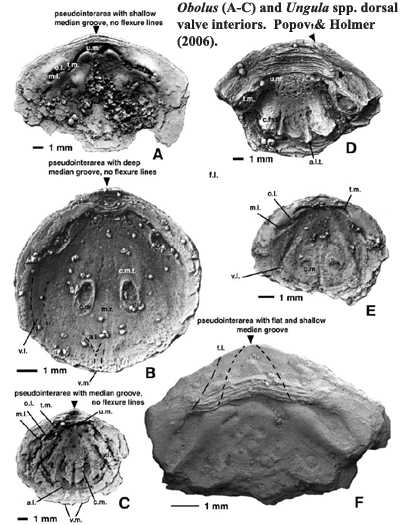
("Dolgellian" Age)
| Palaeos: Paleozoic |  |
Furongian epoch |
| Cambrian PERIOD | Cambrian Stage X ("Dolgellian" Age) |
| Page Back | Back: Cambrian Stage IX | Back: Middle Cambrian | Up: Furongian | Unit Home |
| Page Next | Next: Tremadoc | Next: Early Ordovician | Timescale |
| Cambrian
Terreneuvian Cambrian Epoch 2 Middle Cambrian Furongian Paibian Cambrian Stage IX Dolgellian Ordovician Early Ordovician Tremadoc Floian |

The Dolgellian is not yet formally recognized by the IUGS. It represents the second half of the Furongian and lasted 2-3 million years. It is also known as the Franconian, Trempealeauan, or Marjuman-Steptoean. The Dolgellian is underlain by the Paiban and dated at 514.1-510 Myr ago by Harland et al.. However, the IUGS has fixed the end of the Cambrian at 495 mya, making the Dolgellian approximately 497 to 495 mya.
|
Phylum : Mollusca
Class: Gastropoda? Order: Bellerophontina Superfamily: Bellerophontoidea Family: Sinuitidae Subfamily: Bucanellinae Owenella antiquata Size: about 1 cm diameterHorizon: Trempealeauan, Locality: Wisconsin Comments: an early Bellerophont drawing from Moore, Lalicker and Fischer, Invertebrate Fossils, McGraw-Hill Book Company Inc, 1952, p.291
|

Phylum : Mollusca
Class: Gastropoda Subclass: "Prosobranchia" Order: Vetigastropoda Superfamily: ?Pleurotomarioidea Family: Sinuopeidae Subfamily: Sinuopeinae Sinuopea sweeti Size: about 2.5 cm tallHorizon: Trempealeauan, Locality: Wisconsin Comments: an early Bellerophont drawing from Moore, Lalicker and Fischer, Invertebrate Fossils, McGraw-Hill Book Company Inc, 1952, p.291
|
||

Phylum : Mollusca
Class: Gastropoda Subclass: Eogastropoda Order: Euomphalina Superfamily: Ophiletoidea Family: Ophiletidae Knight, 1956 Schizopea normalis Size: about 2.5 cm wideHorizon: "Upper Cambrian" (Eminence Dolomite) Locality: Missouri Comments: a representative of a very primitive gastropod lineage. In this species the body whorl partially uncoiled. Although this means the shell was less protected, it is possible that the lesser number and efficiency of preditors at this time meant that the animals were not unduley disadvantaged. Later biological "arms races" would lead to more tightly coiled shells. syn: Dirhachopea normalis. Drawing from Moore, Lalicker and Fischer, Invertebrate Fossils, McGraw-Hill Book Company Inc, 1952, p.291
|
|
A new group that appeared although still locally and in small numbers at this time were the Cephalopods (see above right). Several orders of Nautiloids - Plectronocerida, Yanhecerida, Protactinocerida, and Ellesmerocerida came upon the scene, but only the Ellesmerocerids were to survive the end Cambrian mass-extinction and give rise to the rest of the Cephalopods in the early Ordovician onwards [Teichert 1988]
 Annelida
Annelida
Work on Ediacaran forms in the 1980's suggested that Spriggina was a Pre-Cambrian annelid, but this now seems unlikely. Scolecodonts, parts of the complex jaw apparatus of polychaete worms, have been reported from the Furongian, but they are not common until the Late Ordovician. We understand that new Ediacaran finds may push the date back again. However, the present concensus seems to be that definitive annelids had barely differentiated from their "Procoelomate" stem by the Furongian.
Several groups of orthid brachiopods thrived during the Dolgellian, including the early protorthoids and lingulids, as well as more derived forms such as the Billingsellida and Orthodina. Lingulates were probably the most succesful brachiopod group in Dolgellian times. Relatively advanced forms, such as the siphonotretid lingulates appeared for the first time during the Furongian. They underwent a considerable expansion during the Dolgellian and included Ungula, Obolus, Schmidtites, and Helmersenia. Sturesson et al. (2005); Popov & Holmer (2003).
No Bryozoa are known before the Early Ordovician. Possibly, in fact probably, they were present as soft-bodied forms during the Dolgellian.
Corals were just getting started during the Dolgellian, and are represented in the fossil record by a few early rugose forms. Anenomes (Anthozoa) have been described from the Early Cambrian of China, so they were undoubtedly present in the Dolgellian. However, little is known of them. Essentially modern scyphozoans (jellyfishes) have been recovered from mass-stranding events dating from the preceeding Paiban Age of Wisconsin. Hagadorn et al. (2002).
Furongian echinoderm faunas are fairly sparse compared to those of the Middle Cambrian. They include stylophorans (only cornutes -- mitrates had not yet appeared), eocrinoids, and blastozoans (including rhombiferans) with occasional edrioasteroids and perhaps solutes. Lee et al. (2005). Homalozoans had undergone an extensive radiation in the Early and Middle Cambrian; but, by the Dolgellian, several of the Middle Cambrian groups had already vanished. Bottjer et al. (2000), in a rather influential series of papers, explain the faunal changes of the Furongian as a "substrate revolution." Because of the evolution of active infauna and mobile bottom feeders, algal and bacterial mats were replaced by bioturbated soft muds as the most common sea bottom in shallow waters. Consequently, they argue, suspension feeders were forced to adapt by attaching to hard substrates (like brachiopods), developing "root" systems for soft substrates (eocrinoids), or developing some degree of mobility (perhaps stylophorans). The Dolgellian would then represent the final stage of this transformation.
We are less happy with this theory than we once were -- not because it is wrong, but because it seems incomplete. This is a bigger topic than we can take up here, but there are a number of global, or at least broad regional, factors (in addition to local variables) which influence substrate. These include "reef" types, sea level trends, and a number of variables influencing the type and amount of weathering (e.g. oxygen levels, temperature, volcanic activity). The Furongian is a simple case, since none of these additional factors was particularly important. However, the advent of new reef structures in the Ordovician may well have created a new type of firm, semi-organic substrate, which complicates the issue a great deal.
Archaeocyaths, which had been on the wane since the end of the Early Cambrian, became entirely extinct shortly before or during the Dolgellian. More conventional Porifera, particularly Hexactinellida, were abundant and diverse. ATW060130.
| Links |
| Page Back | Unit Home | Page Top | Page Next |